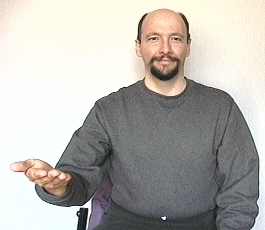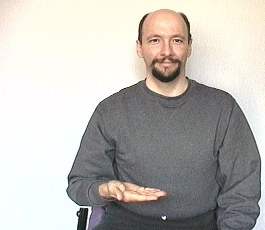American Sign
Language: Grammar
(3)
Grammar links:
1 | 2 |
3 | 4 |
5
| 6
Also see: Inflection
In a message dated 11/20/2002 5:55:43 PM Central Standard Time, Lara writes:
<<Which of the following do you consider "more ASL"?
MY-FAMILY-HAVE-#-ANIMALS.
or
ANIMALS-#-MY-FAMILY-HAVE.
Thank you!
Fellow teacher,
Lara
Lara,
Which of the following do you consider more English?
Phrase 1. "I wouldn't dream of retiring!"
Phrase 2. "Retire? I wouldn't dream of it!"
See my point? They are both, equally English.
Phrase number 1 is more common though.
Someone who isn't familiar with the ins and outs of the English language might think that phrase 1 is more English than phrase 2.Someone who is familiar with English might think that Phrase 2 is better because it seems more complex. But we need to stop and realize that phrase 1 is actually quite complex as well: noun-subject/auxiliary verb+adverb- "contraction"/ verb/preposition/verb intransitive.
Here is another example:
Phrase 3. "Last night my brother's friend came to dinner."
Phrase 4. "A friend of my brother's came to dinner last night."
The double genitive (two possessives: "of" and "brother's") construction in sentence #4 doesn't make it any more or less English than the more common structure of sentence #3. Some English teachers might not like phrase 4 very much and actually criticize a person for using that sentence. Regardless of whether or not the teacher "likes it" millions of English speakers use it.
What "is" and "isn't" ASL is a moving target. For example: the sign WELCOME has several meanings and interpretations. In addition to "welcome" it also means: "hire" and "invite."
This sign is in a state of changing opinion in the Deaf Community.
You will meet some people who say it is an okay response to "thank you."
Quite a few ASL teachers however will tell you it is NOT appropriate to use this sign as a response to "THANK YOU."
The sign "WELCOME / hire / invite" is done by holding the flat hand palm up out away from your body (off to the right a bit) and then bringing the hand in toward your torso.
WELCOME / hire / response:
My recommendation is that you use this sign to mean things like:
"Welcome, come on into my home."
"I hired him."
"I invited her.I recommend that you do NOT use this sign as a response to "Thank you."
So, what should you do if someone tells you "thank you?"
I recommend that you reply with one of these:
TRUE/SURE
FINE
NOTHING-TO-IT
HAPPY HELP-you
THUMB-UP
ANY TIME
NO PROBLEM
When teaching ASL there is a prescriptive approach and a descriptive approach.
Some ASL teachers tell their students that the sign WELCOME is not an ASL sign. Doing so is "prescriptive."
Such teachers are striving to prescribe ASL according to their notions of how ASL should be -- as opposed to what ASL is.
Let me share an amusing story with you:
I remember a conversation (many years ago) with an ASL instructor named ________ (name on file). Near the beginning of the conversation I had signed WELCOME in response to him thanking me for something. He "corrected" me and indicated that WELCOME wasn't an ASL sign (we are both interested in what is and isn't ASL so it wasn't as rude as you might imagine). I questioned him about it and apparently he had recently been to some workshop or seminar and a person with letters behind their name who lived more than 50 miles away (which means that person must be an expert, heh) had told everybody at the seminar that the sign WELCOME isn't an "ASL" sign.
I asked ________ (name on file) what he preferred instead and he gave me the usual, "SURE, THANK YOU, THUMBS-UP, FINE" replacements. I said "OH-I-SEE" and we went on with our conversation. (Of course I already knew and used those signs regularly as well.)
Now here's the funny part, near the end of our half-hour long conversation on my doorstep, I thanked him for coming by and he without thinking signed "WELCOME!"
I pointed out his usage of the "forbidden sign" and he did a major "gulp" and turned a pretty shade of red.
So, there you have an example of a Deaf ASL instructor who for most of his life has signed "WELCOME" in response to "thank you" and then he attends a workshop and has some other Deaf ASL instructor announce that "WELCOME" is not an ASL sign. So now he becomes an evangelist and starts spreading the message that you shouldn't sign "WELCOME" because it is not what Deaf people "do." (Even though he is Deaf and obviously he "does" it). After a while, enough people repeat that same message: "WELCOME" is not a good response to 'Thank you' in ASL." At some point, after enough people spread and accept that message it will become the new standard! It will become the new normal. It will stop being prescriptive and it will become descriptive due to the passage of time and adoption by the "typical" Deaf person.
A descriptive approach to ASL instruction simply tells the students what is currently out there being used by the Deaf Community without trying to "preserve, memorialize, or de-English" it.
The fact is thousands and thousands of Deaf people do use the sign WELCOME. Plus, numerous recognized experts in the field of ASL have documented the "WELCOME" sign in various ASL dictionaries and instructional texts.
Some examples:
The text "A Basic Course in American Sign Language" by Tom Humphries, Carol Padden and Terrence J. O'Rourke lists the sign as "HIRE, INVITE and then includes the word "welcome" in lowercase.
Rod Butterworth in the Perigee Visual Dictionary of Signing: An A to Z guide to over 1,200 signs of American Sign Language, lists the sign as meaning WELCOME, "a common gesture of politeness and acceptance."
Elaine Costello in the Random House American Sign Language dictionary (1st ed.), includes the sign--and what's more--SHE INITIALIZES IT with a "W"!
Martin Sternberg included the WELCOME sign in "American Sign Language: A Comprehensive Dictionary."
I could go on, there are others, those are just the first four I grabbed off my shelf, but you see my point.
These people are "awesome" signers and they included "WELCOME" in their ASL texts.
The sign WELCOME is prominently listed in dozens of major ASL dictionaries and is instantly recognized by every adult native Deaf ASL signer I have met.
So, should YOU use the sign WELCOME in response to being told "thank you?"
My recommendation is "no". The sign is "controversial" and from all indications the "tide" is turning against the WELCOME sign being used as a response to "thank you." Thus if you use the sign WELCOME as a response to "thank you" it will likely have one of two results:
1. The other person doesn't care one way or another how you sign WELCOME.
2. The other person will judge you as not being familiar with how Deaf people do ASL.
Why risk it? Instead just use WELCOME within the limits of what it is used by adult native Deaf ASL signers and use other signs, (SURE, FINE, THUMB-UP, ANY-TIME, NO-PROBLEM) in response to "thank you."---------------------
Now, in specific response to your question of which is "more" ASL of the two:MY-FAMILY-HAVE-#-ANIMALS
or
ANIMALS-#-MY-FAMILY-HAVEThey are both ASL.
The first one is Subject/Predicate. The predicate consisting of a transitive verb and a noun.
I notice you use the # symbol, (which goes by many names: number sign, crosshatch character, pound sign, hash, octothorpe, etc.)In ASL Gloss, that symbol is used to indicate the lexicalization of a fingerspelled word. (For example: #ALL, #WHAT, #BUSY)
I figure you are not indicating that the sign "ANIMALS" is lexicalized, but rather indicating a "variable number" of ANIMALS.Compare that to the concept of "MANY."
MY FAMILY HAVE MANY ANIMAL
That sentence seems fine.But what happens when we exchange MANY for a "number" in the second version of the sentence. Which looks better?
ANIMALS MANY, MY FAMILY HAVE!
MANY ANIMALS, MY FAMILY HAVE!
ANIMALS, MY FAMILY HAVE MANY!
If you are like me, you chose the last one.
I don't see (imagine) the sentence "ANIMALS #, MY FAMILY HAVE" really being used much. Topicalizing the noun-object ANIMALS works fine, but topicalizing an adjective+noun-predicate just doesn't work that well..This is what I'd recommend instead:
ANIMALS, MY FAMILY HAVE #.
Try it and see if it doesn't, "feel" better.
But remember, they are both ASL:
MY-FAMILY-HAVE-#-ANIMALS.
and
ANIMALS, MY FAMILY HAVE #.
Ask around though and most people will tend to pick the one that looks "least" like English.Truth be told the appropriateness of which one you use is tied to "register variation."
In a more formal situation Deaf will tend to sign fewer topicalizations. In a less formal situation we tend to topicalize more. So, which one is "better" ASL will depend on who is in your audience.
Take care.
Dr. Bill--- BillVicars@ wrote:
>
> In a message dated 4/1/2005 9:35:10 AM Pacific
> Standard Time,
> smdaniluk@ writes:
>
> Hello Dr. Vicars,
I have a question about the use of pronouns "you" vs. "yourself" and "he/she" vs. "himself/herself". I find it very confusing to see sentences like "He himself Deaf", instead of "He Deaf", or as in your lesson 35, "Motorcycle you have?", but in another sentence "yourself", not "you" is used when asking someone if he wished he had a hearing aid.
When should "-self" be used and what's the difference? Thank you so much.
> Suzanne _______
> Houston, Texas
>
>
>
> Suzanne,
> In English you might occasionally ask someone if
> they wanted "their own"
> hearing aid or "their own" apartment.
> For example
> Compare these two sentences:
> I want an apartment.
> I want my own apartment.
>
> The second sentence has a different meaning. It
> indicates that the person
> wants to be independent.
> How would we express that meaning via ASL? We would
> do so by using the sign
> "MYSELF."
> PRO-1 WANT MYSELF A-P-T = I want my own apartment
>
> Now consider these two sentences:
> English:
> Do you wish you had a hearing aid?
> Do you wish you had a hearing aid of your own?
>
> Possible interpretation:
> YOU WISH YOU HAVE HEARING-AID?
> YOU WISH YOU YOURSELF HAVE HEARING-AID?
>
> The second sentence implies that the person asking
> the question has a
> hearing aid or that the two people in the
> conversation have been interacting with a
> person who has a hearing aid.
>
> Do I use the sentence "HE HIMSELF DEAF?" If so,
> which lesson?
> Let me give you an instance where you might see the
> "...HIMSELF DEAF"
> concept used appropriately.
> Suppose you were telling a story and wanted to say:
> "There was a deaf man
> who bought a motorcycle."
> HAPPEN MAN HIMSELF DEAF BOUGHT MOTORCYCLE.
>
> Cordially,
> Dr. V


